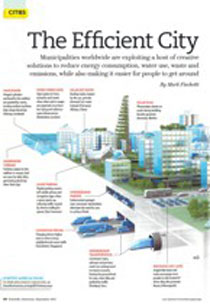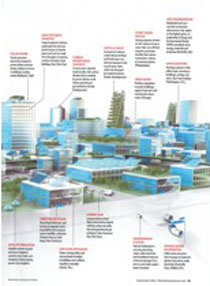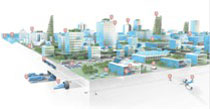
Biopolitics of Sustainability. Alberto Clementi |
 |
After our trial issue of number zero, we are starting EcoWebTown with this first issue dedicated primarily to the experiences of London as it prepares for the upcoming Olympic Games. London having explicitly put itself in the running as a candidate to become the “sustainability capital of Europe” is a valid subject within the programme of this review, which intends to actively contribute to spreading the culture for Sustainability Sensitive urban projects, considering it a necessary prospective for the urban planning and architecture of our times. In this perspective, the far-reaching forecasts for the long term plans for the city of the Games, and in particular the programmed disposal and reuse of the phases of the Olympic works, appears to offer an important lesson, within which we can find significant solutions favouring new sustainability in urban planning.
Together with these reflections on the experiences of London, the review inaugurates a work of critical excavation on positions which are influential on the thought behind projects for sustainable city projects, probing the meaningfulness and the utility itself when confronting contemporary challenges.
Particularly illuminating in this sense is the contribution of Felix Guattari, brought back by Andrea Cavalletti using the happy expedient of an impossible interview. The interview, built from a selection and adaptation of extracts from the works of the great French philosopher, warns us not to try and squeeze the idea of ecology into that of environmental ecology, observing that in particular this latter often cohabits ambiguously with regressive ideologies, as seen under cruel dictatorships, and is at any rate idyllic as regards nature. He comes down as decisively in favour of a wider definition of ecology. The interview invites us to consider contextually the bio-political dimension , -social and existential-, to be entwined with that which is environmental, in search of renewed relationships between environmental rationality, social changes and new forms of organisation of individual subjectivity.
From this point of view, Guattari’s intuitions introduce a direction in research – radically different but in line with, in its conclusions, the theorizing inaugurated by Bateson of ecology as a science of the relations among variable complexes (G. Bateson, Steps to an Ecology of Mind, 1972) – which seem perfectly in tune with the need to formulate a more complex concept of sustainability, including in particular those dimensions which are equally relevant when formulating social, economic and mental policy. Something like this has at any rate already occurred partially on a European level, where in official documents sustainability has taken on a role of mediation between environmental, social and economic questions attributing to projects the responsibility of reconciling all the several issues.
The increasing complexity of the way we approach sustainability has forced us to focus on the subjects of the debate and of future research that goes beyond those perspectives which have become necessary because of our increasing knowledge of environmental processes and of their systematic use in formulating/evaluating urban and territorial projects. It is sufficient that one reinforce the strategic component in the plans and projects, paying explicit attention to economic and social processes (and even changing preferences sensibilities of the individuals, as Guattari would say). Indeed it is fundamental to work on the reciprocal interdependences among the several dimensions which are in play, and which will together structure the strategies of interventions aiming at sustainability.
The urgency of perfecting both our theoretic and operative knowledge of the complex ecological metabolisms that preside over the transformation of the settled environment is obvious. This will offer instruments for the adoption and evaluation of projects less empirical and discretional than current ones. At the same time, it is necessary to reintegrate in a common vision the several dimensions in play, -environmental, economic and social-, with schemes that are conceptually more complex and operatively more effective.
As I have had the occasion to state recently (in P. Barberi ed., Temi per l’architettura e l’urbanistica, (Themes for architecture and urban planning) to be published) the ideas adopted forty years ago by Reyner Banham describing the peculiarities of how Los Angeles functions and the effects on local architectural languages are still fertile territory and rich in unexplored potential (R. Banham, Los Angeles, The Architecture Of Four Ecologies, 1971) Banham’s innovative way of interpreting ecology initiated a totally new line of research. Now one combines many data sets: geographic, climatic, landscape, social habit, individual styles of life, infrastructure use, settlement patterns, architectonic languages, figure di senso e immaginari all characterising the differing contexts.
Returning to the seminal intuition, that unfortunately has not yet gained a wide enough following, the sustainable city as a positive entwining of relational ecologies must be rethought corresponding to several specific modality contexts: the reproductive use of local resources, the functioning of the environment, styles of life, the well-being of the population, the use of the infrastructure, the construction of housing, social representation and the elaboration of architectonic languages.
Creating a pertinent combination of the several dimensions in play, both knowledge and action aspects, brings the value, sustainability, to the heart of the choices of the plan and project, degrading the role of environmental technology which has usually been decisive, for both buildings as well as built up areas.
Innovation in architectonic and urban design culture is playing a high stakes game by emphasizing the need to consider sustainability values right from the concept phase of the urban design project. It eschews the remedial solutions elaborated by increasingly complex technologies, through it is now possible – especially if we ignore the costs – to make any buildings sustainable or even entire neighbourhoods. The challenge strikes at the very way we conceive projects of urban transformation, not only as an added value that brings benefits in the reproductive use of local resources, and increases the livability of urban spaces, but precisely as a device for action that, by interiorizing the objectives of sustainability, makes the choice of attitude and the configuration of the newly planned urban developments conform differently.
In truth it has not yet been fully demonstrated that sustainable architectonic and urban planning projects really lead to new settlement patterns, but the increasingly frequent experiments in Europe and elsewhere demonstrate that a new sensibility is emerging, and that the affirmation of a new esthetic of sustainability which enriches contemporary architecture and urban planning is coming in the near future.
Let me express one final wish. I hope that soon we will be able to discuss concrete examples in Italian cities of sustainable projects, even better if they are a restructuring of existing neighbourhoods than that they are for new ones.



